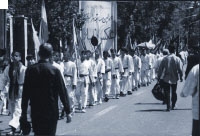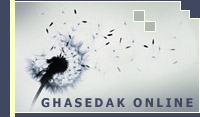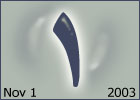Issue 1
Vahid Harati
 Quite often, here in Canada, we may turn on our TVs and hear the word "Iran". The recent death of Zahra Kazemi in an Iranian prison has shift the focus of the Canadian media to Iran. (This is why on a Monday night, you may tweak your TV to CBC Newsworld and watch a documentary called “Iran, Veiled Appearances”. The documentary which is directed by Thierry Michel was originally 90 minutes but cut to 45 minutes to fit the one hour slot of CBC programs.
Quite often, here in Canada, we may turn on our TVs and hear the word "Iran". The recent death of Zahra Kazemi in an Iranian prison has shift the focus of the Canadian media to Iran. (This is why on a Monday night, you may tweak your TV to CBC Newsworld and watch a documentary called “Iran, Veiled Appearances”. The documentary which is directed by Thierry Michel was originally 90 minutes but cut to 45 minutes to fit the one hour slot of CBC programs.
Thierry Michel, the Belgian director of the “Iran, Veiled Appearances”, is well known for making both fiction and documentary films, notably "Kids from Rio", "Zaire, the snake's cycle". He traveled twice to Iran for his documentary and took the advantage of having an Iranian cameraman, Mr. Khosroshahi, presumably to reduce the production cost of his documentary.
The documentary starts with showing the students of school of Drama in University of Tehran. The girls and boys dance together as part of their class work. Then the camera goes to a mosque, a student residence, Tehran parks and a wedding party to capture the everyday life of Iranian people. It also shows a number of short clips from the speeches made by the reformist leaders in different occasions.
Like most of other documentaries about Iran, which have been made in the last several years, it tries to highlight the contradictions in the life of Iranian people. The director takes his camera once to a wedding party where girls and boys are dancing together and then shows women, all covered with chador, marching and shouting pro-hardliner slogans. Unfortunately, the documentary fails to discover the roots of these contradictions in order to explain how they could live together. The director also does not dig into the relationship between social changes and political atmosphere of the country. In order to make any documentary, extensive research must be done and this is what seems to be forgotten in this documentary, considering that Thierry Michel was not a political specialist of Iran.
Another weakness of the documentary is when it tends to categorize people into two groups of Islamists and non-Islamists. This gives the very wrong impression to the audience that Islamists are always the hardliners who try to cease the reform movement, and non-Islamists are the reformists. Considering that many of the reformists are actually very religious, this could become misleading and confusing. For instance, the viewer may get surprised seeing the wife of one the political prisoners interviewed while wearing full Islamic dress.
Looking back to the last few years, we can see that a descent documentary about Iran is missing. Non-Iranian had never had an accurate image of what is happening in Iran. Many years ago Iran was known among people in the west for taking over the US embassy and now it is known for nuclear weapons. If we, as Iranians, would like people in the west to get a more realistic image of our country and its people, we have to take a step forward. One way of doing that could be making documentaries about Iran with an Iranian perspective rather than a western one. If they make a documentary about us, they may not do what we expect.












